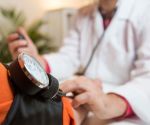A “soft tissue artifact” may show up on an image produced by a nuclear stress test. During a nuclear stress test you receive an injection of a special radioactive dye that then travels through your blood vessels. A nuclear camera is used to take color-coded pictures of the heart to measure blood flow before, during and after exercise.
After a stress test, your physician may mention that you have “soft tissue artifact,” or “soft tissue attenuation.” What this means is that soft tissue, such as breast tissue, is showing up on the image created by the stress test. Soft tissue artifact can give the false appearance of an area of reduced blood flow to the heart.
Continue Learning about Heart Failure
Important: This content reflects information from various individuals and organizations and may offer alternative or opposing points of view. It should not be used for medical advice, diagnosis or treatment. As always, you should consult with your healthcare provider about your specific health needs.













